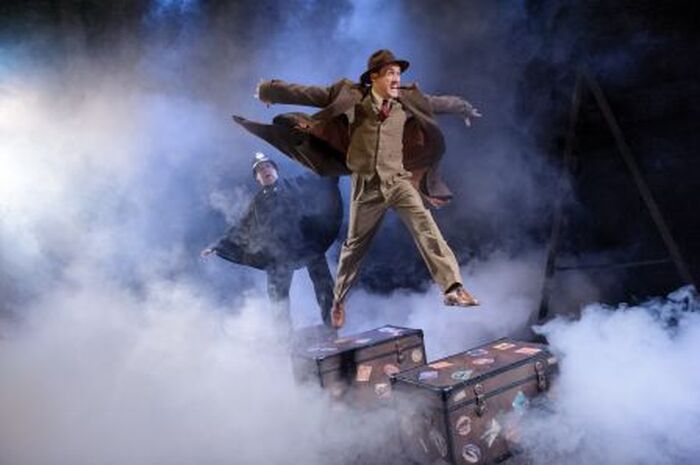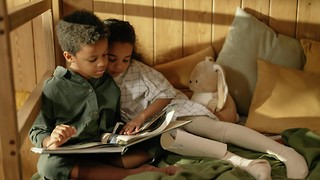Impossible to keep laughter undercover at ‘The 39 Steps’
This riotous play delivers an entertaining parody that, despite occasional slips, doesn’t fail to charm.

Richard Hannay, a bored, middle-aged man in 1935 London, goes to see a West End show. Upon meeting an elusive woman who reveals she’s a spy, he is swept into a world of espionage, manhunts, and murder. Soon, an organisation called The 39 Steps is hot on his trail. In this production at the Pembroke New Cellars, a feat of farce and adrenaline gains in confidence as the chase progresses, reaching its heights in comedy when the cast revels in their characters amidst the fast-paced chaos.
The 39 Steps works with the tools of the spy genre and its best moments come when the play laughs at the tropes it parodies while letting the audience indulge in them, introducing a mix of intrigue and romance. If the mechanisms of parody occasionally feel too transparent — excessive comedy collapsing in on itself, with actors attempting a range of characters and their corresponding accents to varying degrees of success, it is fortunate that the play does not take itself too seriously, and neither should its audience.
“Virtuoso performances and dexterous stagecraft”
Only a focused and attentive director like Amenie Groves could have steered the play successfuly through its many moving parts: stagecraft, role-juggling, slapstick. The minimal set of an armchair, a costume rail with a drape, and four chairs transform into many settings: a bed, a theatre, a plane, and a train, amongst others. Actors hurry on and off with costumes, bits of the set, and props, as they construct the night’s entertainment before our eyes, adding a wonderfully metatheatrical dimension to the play.
The effects of these scene transitions range from comically chaotic, highlighting the absurdity of the 150+ characters played by a cast of four, to highly witty, with slick and unexpected transitions like taking off a coat to prompt the transformation into a completely different role. The line between dramatic self-awareness and unseriousness does become slightly blurred from time to time as members of the cast visibly try to keep a straight face. But, the boundaries of parody allow for the occasional corpsing in this joyful romp.
“Comically chaotic and highly witty”
One of the play’s sensational scenes was a train chase sequence, a comedic climax that audiences should look forward to, in which all four of the cast onstage delivered impressive physical comedy. The cast creates a dynamic ensemble, though their individual performances are equally strong. Sam Thompson deftly embodies a characteristic inter-war British gentleman: slightly buffoonish and confused, but rational and no-nonsense to the extreme. A steady presence amidst the role-switching that ensues, we grow fond of Thompson’s Hannoy who delivers delightful moments such as his riveted, impromptu patriotic speech as an unknowing guest speaker at a hustings.
A stellar performance from Blossom Durr elevated the comedy of the play. Attention to expressive detail allowed her to switch between roles as smoothly as between wigs. Playing all three leading female roles highlighted the satire of the often limited and stereotyped roles accorded to women in the spy genre. Durr embodies a sleek spy with moments of unexpected farce, just as well as she does a timid, self-sacrificing Scottish housewife, or a prim and proper woman swept out of her comfort zone.
The two Clowns, Nadia Lines and Grace Wakeman, valiantly juggle numerous characters with adrenaline and high energy which props up the play. This well-rehearsed duo delivers many moments of slapstick, garnering a chorus of laughs from the audience. Even the most serious viewer would struggle not to be charmed into laughter by their knowing quips and unflagging commitment to their roles. Initially, these more energetic roles come off as slightly strained. With so much energy thrown at a role, the humour of the play can be overwhelmed: subtleties are missed, and the performer can start to eclipse the character. Ultimately, the duo’s chemistry shines through and their comically convoluted and dramatic finale works splendidly.
Both director and cast showcase their versatility when the play becomes touching, as the fast-moving world of espionage recedes to showcase the camp romance between two of the characters, creating both laughter and poignancy. The sound and lighting design by Robert Woodland enhances these lovestruck moments, briefly transforming the play into an old-timey romantic film.
The show’s exaggerated comedy and farce won me over as the play went on, until I couldn’t hold back laughter or wipe the grin off my face. Virtuoso performances and dexterous stagecraft make The 39 Steps an experience not to be missed.
 News / Uni offers students £55k in payouts31 October 2025
News / Uni offers students £55k in payouts31 October 2025 News / Uni error forces deeper spending cuts31 October 2025
News / Uni error forces deeper spending cuts31 October 2025 News / College rowing captains narrowly vote to exclude trans women31 October 2025
News / College rowing captains narrowly vote to exclude trans women31 October 2025 News / Students launch women’s society excluding trans women31 October 2025
News / Students launch women’s society excluding trans women31 October 2025 News / Students allowed to use AI, says new uni guidance31 October 2025
News / Students allowed to use AI, says new uni guidance31 October 2025










